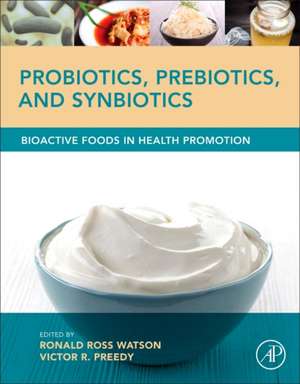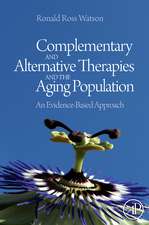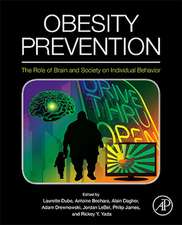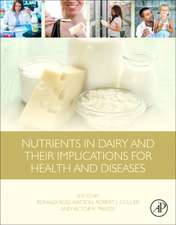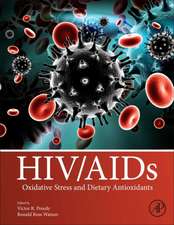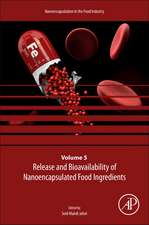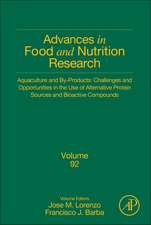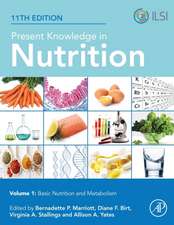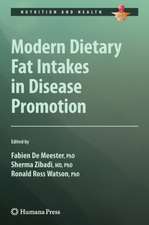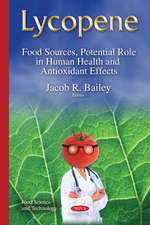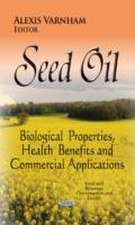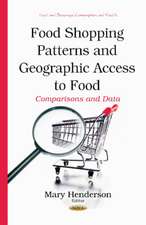Probiotics, Prebiotics, and Synbiotics: Bioactive Foods in Health Promotion
Editat de Ronald Ross Watson, Victor R. Preedyen Limba Engleză Hardback – 12 oct 2015
- Offers a novel focus on synbiotics, carefully designed prebiotics probiotics combinations to help design functional food and nutraceutical products
- Discusses how prebiotics and probiotics are complementary and can be incorporated into food products and used as alternative medicines
- Defines the variety of applications of probiotics in health and disease resistance and provides key insights into how gut flora are modified by specific food materials
- Includes valuable information on how prebiotics are important sources of micro-and macronutrients that modify body functions
Preț: 743.00 lei
Preț vechi: 898.02 lei
-17% Nou
Puncte Express: 1115
Preț estimativ în valută:
142.22€ • 154.53$ • 119.54£
142.22€ • 154.53$ • 119.54£
Carte tipărită la comandă
Livrare economică 14-28 aprilie
Preluare comenzi: 021 569.72.76
Specificații
ISBN-13: 9780128021897
ISBN-10: 0128021896
Pagini: 938
Ilustrații: illustrations
Dimensiuni: 216 x 276 x 48 mm
Greutate: 2.79 kg
Editura: ELSEVIER SCIENCE
ISBN-10: 0128021896
Pagini: 938
Ilustrații: illustrations
Dimensiuni: 216 x 276 x 48 mm
Greutate: 2.79 kg
Editura: ELSEVIER SCIENCE
Cuprins
Part 1: Prebiotics in Health Promotion
1. Prebiotics and probiotics: An assessment of their safety and health benefits
2. Pre- and Probiotic Supplementation in Ruminant Livestock Production
3. Prebiotic addition in dairy products: processing and health benefits
4. Low lactose Prebiotic-enriched milk
5. Intestinal microbiota in breast-fed infants: insights into infant-associated bifidobacteria and human milk glycans
6. Probiotics and Prebiotics for Promoting Health: via Gut Microbiota
7. Prebiotics in human milk and in infant formulas
8. Prebiotics and Probiotics in infant nutrition
9. Synthesis of Prebiotic Galactooligosaccharides: Science and Technology
10. Prebiotics as protectants of lactic acid bacteria
11. Prebiotic agave fructans and immune aspects
12. Prebiotic use in children
13. Structural characteristics and prebiotic effects of lotus seed resistant starch
Part 2: Probiotics in Food
14. Probiotic Lactobacillus strains from Iranian traditional cheeses
15. Safety of Probiotic Bacteria
16. Stressors and food environment: towards strategies to improve robustness and stress tolerance in probiotic
17. Effect of food composition on probiotic bacteria viability
18. Probiotics and antibiotic use
19. Multistrain Probiotics: the present forward the future
20. Production of Probiotic Cultures and Their Incorporation into Foods
21. Prebiotics and Other Microbial Manipulations in Fish Feeds: Prospective Update of Health benefits
22. Current and future applications of bacterial extracellular polysaccharides
23. Probiotic and prebiotic dairy desserts
24. Lactobacillus paracasei-enriched vegetables containing health promoting molecules
25. Probiotics from the olive microbiota
26. Kimchi (Korean fermented vegetables) as a probiotic food
27. Probiotics as potential adsorbent of aflatoxin
Part 3: Synbiotics: Production, Application, and Health Promotion
28. Beta-glucans and synbiotics
29. Probiotics and synbiotics in lactating mothers
30. Symbiotics and the immune system
31. Synbiotics and immunization against H9N2 Avian influenza virus
32. Probiotics, prebiotics, synbiotics and foodborne illness
33. In vitro screening and evaluation of synbiotics
34. Synbiotics and infantile acute gastroenteritis
35. Symbiotics, probiotics and fiber diet in diverticular disease
36. Gut Microbiota: Impact of Probiotics, Prebiotics, Synbiotics, Pharmabiotics and Postbiotics on Human Health
37. Potential benefits of probiotics, prebiotics, and synbiotic on the intestinal microbiota of the elderly
38. Synbiotics in gastrointestinal surgery
39. Probiotics, Prebiotics, Synbiotics and other strategies to modulate the gut microbiota in Irritable Bowel Syndrome (IBS)
40. Gut microbiota & IBS
41. Synbiotics: a new strategy to improve immune system from gut to the peripheral sites
42. Probiotics and prebiotics for prevention of viral respiratory tract infections
43. Synbiotics in the Intensive Care Unit
44. Properties of probiotic bacteria: a proteomic approach
45. Symbiotic organisms and gut epithelial homeostasis
46. Non prebiotic actions of prebiotics
Part 4: Probiotics in Health
47. Probiotics and physical strength
48. Probiotics in Invasive Candidiasis
49. Probiotics and usage in bacterial vaginosis
50. Evidence and rational for probiotics to prevent infections in the elderly
51. Probiotics usage in childhood Helicobacter pylori infection
52. Lipoic acid function and its safety in Multiple sclerosis
53. Probiotics and health: What publication rate on probiotics, prebiotics and synbiotics implies?
54. The Cholesterol lowering effects of probiotic bacteria on lipid metabolism
55. The Use of Prebiotics, Probiotics, and Synbiotics in the Critically Ill
56. Gynecological health and probiotics
Part 5: Probiotics and Chronic Diseases
57. Probiotics in inflamatory bowel diseases and cancer prevention
58. Resistant starch as a bioactive compound in Colorectal Cancer prevention
59. Probiotics in cancer prevention, updating the evidence
60. Cardiovascular Health and Disease Prevention: Association with Foodborne Pathogens and Potential Benefits of
Probiotics
61. Probiotics usage in heart disease and psychiatry
62. Intestinal microbiota and susceptibility to viral infections. Role of probiotics.
63. Probiotics and usage in urinary tract infection
64. Probiotics: immunomodulatory properties in allergy and eczema
65. Prebiotics and Probiotics for the Prevention and Treatment of Food Allergy
66. Prebiotics and probiotics for the prevention and treatment of allergic asthma
67. Amelioration of Helicobacter pylori induced PUD by probiotic lactic acid bacteria
1. Prebiotics and probiotics: An assessment of their safety and health benefits
2. Pre- and Probiotic Supplementation in Ruminant Livestock Production
3. Prebiotic addition in dairy products: processing and health benefits
4. Low lactose Prebiotic-enriched milk
5. Intestinal microbiota in breast-fed infants: insights into infant-associated bifidobacteria and human milk glycans
6. Probiotics and Prebiotics for Promoting Health: via Gut Microbiota
7. Prebiotics in human milk and in infant formulas
8. Prebiotics and Probiotics in infant nutrition
9. Synthesis of Prebiotic Galactooligosaccharides: Science and Technology
10. Prebiotics as protectants of lactic acid bacteria
11. Prebiotic agave fructans and immune aspects
12. Prebiotic use in children
13. Structural characteristics and prebiotic effects of lotus seed resistant starch
Part 2: Probiotics in Food
14. Probiotic Lactobacillus strains from Iranian traditional cheeses
15. Safety of Probiotic Bacteria
16. Stressors and food environment: towards strategies to improve robustness and stress tolerance in probiotic
17. Effect of food composition on probiotic bacteria viability
18. Probiotics and antibiotic use
19. Multistrain Probiotics: the present forward the future
20. Production of Probiotic Cultures and Their Incorporation into Foods
21. Prebiotics and Other Microbial Manipulations in Fish Feeds: Prospective Update of Health benefits
22. Current and future applications of bacterial extracellular polysaccharides
23. Probiotic and prebiotic dairy desserts
24. Lactobacillus paracasei-enriched vegetables containing health promoting molecules
25. Probiotics from the olive microbiota
26. Kimchi (Korean fermented vegetables) as a probiotic food
27. Probiotics as potential adsorbent of aflatoxin
Part 3: Synbiotics: Production, Application, and Health Promotion
28. Beta-glucans and synbiotics
29. Probiotics and synbiotics in lactating mothers
30. Symbiotics and the immune system
31. Synbiotics and immunization against H9N2 Avian influenza virus
32. Probiotics, prebiotics, synbiotics and foodborne illness
33. In vitro screening and evaluation of synbiotics
34. Synbiotics and infantile acute gastroenteritis
35. Symbiotics, probiotics and fiber diet in diverticular disease
36. Gut Microbiota: Impact of Probiotics, Prebiotics, Synbiotics, Pharmabiotics and Postbiotics on Human Health
37. Potential benefits of probiotics, prebiotics, and synbiotic on the intestinal microbiota of the elderly
38. Synbiotics in gastrointestinal surgery
39. Probiotics, Prebiotics, Synbiotics and other strategies to modulate the gut microbiota in Irritable Bowel Syndrome (IBS)
40. Gut microbiota & IBS
41. Synbiotics: a new strategy to improve immune system from gut to the peripheral sites
42. Probiotics and prebiotics for prevention of viral respiratory tract infections
43. Synbiotics in the Intensive Care Unit
44. Properties of probiotic bacteria: a proteomic approach
45. Symbiotic organisms and gut epithelial homeostasis
46. Non prebiotic actions of prebiotics
Part 4: Probiotics in Health
47. Probiotics and physical strength
48. Probiotics in Invasive Candidiasis
49. Probiotics and usage in bacterial vaginosis
50. Evidence and rational for probiotics to prevent infections in the elderly
51. Probiotics usage in childhood Helicobacter pylori infection
52. Lipoic acid function and its safety in Multiple sclerosis
53. Probiotics and health: What publication rate on probiotics, prebiotics and synbiotics implies?
54. The Cholesterol lowering effects of probiotic bacteria on lipid metabolism
55. The Use of Prebiotics, Probiotics, and Synbiotics in the Critically Ill
56. Gynecological health and probiotics
Part 5: Probiotics and Chronic Diseases
57. Probiotics in inflamatory bowel diseases and cancer prevention
58. Resistant starch as a bioactive compound in Colorectal Cancer prevention
59. Probiotics in cancer prevention, updating the evidence
60. Cardiovascular Health and Disease Prevention: Association with Foodborne Pathogens and Potential Benefits of
Probiotics
61. Probiotics usage in heart disease and psychiatry
62. Intestinal microbiota and susceptibility to viral infections. Role of probiotics.
63. Probiotics and usage in urinary tract infection
64. Probiotics: immunomodulatory properties in allergy and eczema
65. Prebiotics and Probiotics for the Prevention and Treatment of Food Allergy
66. Prebiotics and probiotics for the prevention and treatment of allergic asthma
67. Amelioration of Helicobacter pylori induced PUD by probiotic lactic acid bacteria
Recenzii
"An immediately identified strength of the book is the logical flow of the order of parts, which results in a highly readable book…presents new hypotheses and conclusions on the effects of different bioactive components of prebiotics, probiotics, and synbiotics to prevent diseases and improve the health of various groups of the population." --Acta Alimentaria
